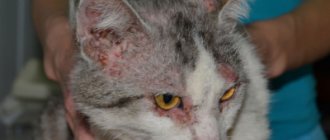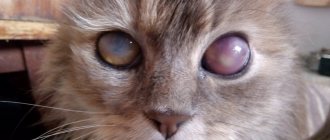Skin diseases are a common occurrence in domestic and farm animals. Pathologies manifest themselves in different ways: hair loss due to attack by parasites, problems with the epidermis and internal disorders. The causes of these symptoms need to be accurately determined. The veterinarian will not only identify the disease, but also prescribe the correct treatment. Some skin diseases can be dangerous to your pet's health.
Sores in cats on the head: Diagnosis of the cause
Diagnosis is carried out in a veterinary hospital.
In Moscow, you can contact the veterinary clinics of the network “Your Doctor” or “Bely Klyk”, as well as the Innovative Veterinary Center of the Moscow Veterinary Academy (IVC MBA).
In St. Petersburg, competent specialists will help you at the clinics “Dog and Cat”, “Lucky”, “Your Doctor”.
In Voronezh, we recommend visiting the blades “Eurovet” and “Cat Matroskin”.
To determine the cause, the veterinarian will take the following measures:
- Examination of the animal with thermometry.
- Anamnesis collection (seasonal or not, new carpet at home, flowers, new animal, vaccinations, food, contact with stray animals)
- Detection of antibody titers during an allergic reaction in the laboratory, less pronounced with food allergies (immunoglobulins G. M), more pronounced with allergies to house dust or pollen (immunoglobulins E)
- General blood and urine analysis.
- Blood chemistry.
- Scraping of the epidermis from the affected areas followed by microscopy.
- Sowing material from the lesion (detection of bacteriological contamination).
- Examination of the animal's hair and skin in the rays of a Wood's lamp (spores and mycelium of microsocopic mushrooms glow with a gentle blue light).
- Microscopy of a hair taken from the periphery of the lesion.
- Cultivation of the fungus on nutrient media in a laboratory (material is taken from the center of the lesion and then transferred to nutrient media).
- Microscopy of deep skin scraping (for diagnosis of ectoparasites).
- Analysis of feces for helminthiasis.
Clinical signs and associated symptoms
The occurrence of ulcers, crusts and other sores in cats may be accompanied by:
- dandruff;
- dulling of wool;
- itching;
- changes in skin pigmentation;
- hair loss;
- temperature rise.
To determine an accurate diagnosis, you will need to examine the cat, collect anamnesis and perform some tests.
A cat scratches sores on its head: If the cause is an allergic reaction
An allergic reaction is the most common cause of itchy sores on a cat's head. The animal scratches them until they bleed, scabs form, and a secondary infection may develop - then the disease is complicated by bacterial contamination.
The fur may come out in the affected areas, but may not be damaged, only sticking together with a pathological secretion.
Watch the video: Veterinarian advice - Skin diseases in cats and their diagnosis
The danger of skin pathologies for humans
Despite the fact that such diseases are an unpleasant phenomenon, most of them are not transmitted to people. Timely and correct prescription of medications makes them not dangerous for their owners.
Infection with different types of lichen and allergic reactions from blood-sucking bites require the use of medications not only for the animal, but also for the owner. They do not pose a threat to life, but the spread of scabs and ulcers throughout the body of a person or pet is not a very pleasant phenomenon, and it needs prompt treatment.
A cat has a sore on its head: Treatment of an allergic reaction
- Rinse the inflamed areas with hydrogen peroxide (2-3% solution).
- Local lotions against itching, against secondary skin infections - antibiotics and/or antifungal drugs (Levomekol, Fungin).
- To eliminate itching, stop itching, antihistamines (Suprastin, Tavegil), in severe cases, single or triple use of Prednisolone subcutaneously is possible.
- Hyposensitization: after successful determination of antibodies in the laboratory, injections of serum at weekly intervals for 10 - 12 weeks (this type of treatment is practiced only in some Moscow clinics).
- Eliminating the allergen (changing food to hypoallergenic, removing carpets, flowers, isolating new animals, etc. - depends on which allergen is identified.
- Also, herbal medicine has proven itself to be effective in eliminating itching and relieving inflammation: compresses, baths, washing, wrapping with tinctures or 10-20-5 solutions of calendula, chamomile, echinacea or St. John's wort. Baths with walnut tree leaves. Washing with infusions of horsetail or pansies, decoctions of walnut leaves.
Special diet
During treatment, dietary products are selected for the cat, the consumption of which reduces the intensity of itching and the likelihood of relapses. Your cat's daily diet should be balanced. It is not recommended to give smoked and sweet foods.
Adviсe:
- If the cat was eating food before the allergy appeared, then purchase a hypoallergenic variety.
- When a cat is fed regular food, pork, potatoes and porridge are removed from the diet. They give fish, butter and vegetables.
- Adding fish oil to food (tuna, salmon, sardines, anchovy) helps reduce itching.
Timely adjustment of the diet and daily monitoring of the animal’s condition are required.
A cat has scabs on its head: If the cause is ectoparasites
The appearance of itchy sores on the head and neck, which animals scratch until they scab, may be caused by infection of the animal with ticks of the species Notoedres cati, Sarcoptes spp. All age groups and all breeds are affected.
It often starts from the outside of the ear and spreads to the head area, later to the body and tail. Severe itching, followed by the appearance of individual pustules, bran-like scales and profuse hair loss.
Like what you're reading? Check out other articles about cat health: Alarm Clock Cat. How to wean your pet from the habit of waking up? – Do cats need to be washed and if so, how? Tips for bathing tailed cats - https://strazhchistoty.ru/cleanup/cleancats/nado-li-myt-koshek.html How to learn to understand your cat? – https://strazhchistoty.ru/cleanup/cleancats/kak-ponimat-koshku.html
Itching caused by helminths
There are a large number of varieties of parasitic worms that take up residence in a cat’s body. They can be:
- round;
- flat;
- tape.
Usually at the very beginning of infection it is difficult to consider any of its symptoms, but after a while the animal:
- loses appetite and activity;
- becomes restless;
- Constantly licks and itches.
Worms found in the intestines are considered almost harmless.
Difficulties with your pet’s health arise when there are too many helminths and their larvae begin to migrate.
The movement of worms throughout the animal’s body is accompanied by the following symptoms:
- sudden weight loss, increased fatigue, growth retardation in small pets;
- disheveled wool;
- enlarged liver and icteric staining of visible mucous membranes;
- disruption of the digestive system, expressed in constipation, vomiting, diarrhea;
- appearance of cough;
- discharge from the eyes;
- itching in the anus;
- presence of blood in feces;
- premature birth or miscarriage in cats;
- convulsions and paresis of the limbs.
The cat may not notice the presence of parasites in the body in small quantities. However, their increase will not only exhaust the animal, but will also lead to its death. The harm caused to pets by worms can be completely different :
- eating lymph, tissue and blood;
- release of substances that promote intoxication;
- damage to the mucous membranes by suction cups, leading to internal bleeding.
After the worms die, decomposition products are formed that poison the animal’s body.
The appearance of parasites leads to metabolic disorders, as a result of which the cat’s skin becomes dry and dandruff appears on it. Just like an allergic reaction, these factors are accompanied by itching, which causes the animal to scratch its neck until it bleeds. A pet can become infected with helminths in the following ways :
- eating raw meat or fish (especially river fish);
- flea bites;
- contacts with other animals.
To prevent itching, which causes painful scratching, animal owners need to regularly take a preventive course using anthelmintic medications.
Sores on a cat's head: Treatment of tick-borne infestation
- General measures: soak the peels with vegetable oils or liquid paraffin and remove. Disinfect toys, brushes, bowls and other things, wipe the surface with hot water, treat the bed with antiparasitic agents (Bolfo-plus spray, Frontline spray).
- Wash with acaricidal agents (shampoos) 1-2 times a week for 2-4 weeks.
- Treat the affected areas with Aversectin ointment 2 times a day until cured.
- Ivermectin injections subcutaneously for a week.
- To support fur restoration - food supplements with essential amino acids and vitamins (Beafar, AgroVetZashchita ).
- Washing or bathing with infusions of thyme, yarrow, cloves, lavender, ivy, horsetail, pansies, bath with walnut leaves and whey.
- Baths with sulfur-containing preparations or shampoos with tea tree oil 1-2 times a week until improvement.
The cat has sores on its head and hair has come out: If the cause is fungal infections
Mainly kittens, old and weakened animals are susceptible to infection with fungal diseases (the latter include cats after suffering severe infectious diseases, receiving drugs that suppress the immune system, and having a meager feeding ration).
The causative agents are microscopic fungi of the species Microsporum Canis, Microsporum gypseum or the genus Trichophyton. Healthy animals, due to their strong immune system, can be asymptomatic carriers of pathogenic fungal spores for a long time.
Infection occurs when fungal spores come into contact with the fur or skin of an animal from environmental objects or through direct contact with a sick animal. The incubation period (the time from the moment of infection to the appearance of the first signs of the disease) ranges from 1 week to 1 month.
Clinically, fungal infections in cats are practically the same. Most often the head, ears, neck and back of the animal are affected, less often the limbs and abdomen.
The disease begins with hair loss in a limited area, the cat scratches the affected area, the skin is covered with scales and crusts, the lesions tend to merge and grow.
With extensive damage, the general condition of the animal may also suffer: appetite worsens, lethargy or, conversely, aggressiveness appears.
The best foods for cats with allergies
Diagnosis of scratching and itching
Itching is probably one of the most unpleasant sensations that can only be relieved by scratching. It has been proven that a person can become psychotic if they experience itching and cannot scratch themselves. Itching in an animal is a clear sign of skin damage, although it can occur before obvious symptoms appear. In veterinary medicine, as in human medicine, itching is distinguished depending on its nature:
- Localized – one or more specific places are itchy, for example, scratching appears only on the face or on the neck and cheeks.
- Generalized – when the cat’s entire body itches.
The cat has sores on the neck, on the head: Treatment of fungal infections
- Local treatment in the form of ointments. (Yam, Sanoderm).
- Local treatment using Fungin spray.
- Use of the therapeutic vaccine Vakderm, Polivac.
- Bathing with antifungal shampoos once every 3 days for 6 weeks.
- For generalized lesions, antifungal drugs are used orally ( Introconazole , Terbafine).
- Complete balanced feeding.
- Use of vitamin and mineral supplements to feed.
- Avoid scratching and licking (wear a collar).
- In long-haired animals, it is advisable to clip the affected areas.
- Washing with vinegar water and horsetail infusion.
Skin tumors
Skin neoplasms are in first place among oncological diseases in animals. By their nature, they are also divided into benign and malignant forms.
The first includes:
- Basalioma. The sore is a pigmented dome-shaped tumor. At the point where it appears, the animal loses its hair.
- Cutaneous histiocytoma. Characterized by a rapidly growing tumor under the skin. A rare pathology for cats.
Malignant skin tumors develop in two cases:
- Squamous cell carcinoma. The disease manifests itself in the nose, eyelids and ears. Metastases spread through the lymphatic system.
- Basal cell carcinoma. Develops from basal cells of the skin. Characterized by rapid growth and a high probability of metastasis.
Precautions for fungal infections in domestic cats
The disease is anthropozoonotic – that is, transmitted from animals to humans and vice versa. Children and the elderly, as well as those weakened by other diseases, are most susceptible to infection with the fungus.
Therefore, if there are children, old people or seriously ill people in your house, then of course the most optimal solution would be to isolate the sick animal in another room until it has fully recovered.
If the inhabitants of your apartment are all adults and healthy people, then it will be enough to treat the cat’s skin with ointments, wearing gloves and a mask, carry out daily wet cleaning using antiseptics, iron the fabrics with a hot iron, and wash your hands.
Treating scratches at home
If a cat scratches itself until it bleeds, the first step is to treat the wound so that it does not get infected. Regular human ointments are suitable for this.
To avoid further scratching of the skin, the cat should trim its claws and cover the problem area with something (for example, put a special collar or vest on the animal).
If a doctor has diagnosed lichen, the sick animal must be isolated from healthy ones. The fur next to the affected area is shaved off. The affected area is treated with ointments.
If an animal is taking any anti-inflammatory or immunosuppressive drugs, they should be stopped for a while so that the body has the strength to cope with the fungus.
The room in which the cat lives, as well as all objects with which it comes into contact, must be disinfected. Treatment of lichen can take quite a long time, but if its initial stages are detected, the animal will fully recover.
A special diet will help overcome food allergies. A product that causes a negative reaction should be excluded from the diet. You can also purchase commercial food for cats prone to allergies.
Atopic dermatitis can also cause itching. This is also an allergic reaction of the cat’s body, but it is impossible to isolate the exact allergen and completely eliminate it. Atopic dermatitis cannot be cured, but with the help of medications, all negative manifestations of allergies can be eliminated.
If a cat is suffering from a bacterial infection, the first step is to use various ointments. If an animal develops ulcers, the doctor will prescribe a course of antibiotics.
If the disease becomes chronic, the veterinarian takes microbiological tests. This is necessary to prescribe the most effective treatment for this type of bacteria.
When do you need veterinary help?
Often, scratching is almost harmless and does not cause the animal much discomfort. The owner may not even immediately notice that something is wrong with the pet. Problems begin when bacteria get into the wound. In this case, an abscess may form on the skin. In some cases, without timely treatment, the area of scratching may increase.
We recommend the article: Heat in cats: features, symptoms, deviations from the norm
If an animal scratches a small wound once, there is no need to sound the alarm. Perhaps the cat just overdid it. The wound should be treated and the pet should be monitored.
In what cases should you take your pet to the veterinarian:
- The cat scratches the same place for a long time until it bleeds.
- The area of scratching increases.
- The wound oozes pus or does not heal.
- Scabs form on the affected area of the skin.
- The cat's hair falls out and bald patches form.
- The animal is constantly itching.
Scratching is often one of the symptoms indicating that the animal is unhealthy. In this case, you should pay attention to the general condition of the cat. You should contact your veterinarian if the following symptoms accompany itching:
- Decreased activity or excessive agitation.
- Increased body temperature.
- Lack of appetite.
- Nausea, vomiting, diarrhea.
A cat has a bump on its head: Possible causes
If you find a lump on your pet's head, the reasons may be the following:
- Lipoma formation.
- Abscess formation.
- Metastases of a malignant tumor of any organ.
Lipomas are formed from cells of subcutaneous fatty tissue and are benign formations; with trauma they can degenerate into malignant ones. The reliable reason for their formation, however, like all neoplasms, is unknown.
Abscesses can form at the site of an injury, a bite during a fight with other animals when the immune system is weakened and the wound is contaminated, when the animal has access to the street, or its habitat in the apartment is polluted. The cat's scratching and licking of the wound plays an important role.
Since the formation can be a signal of a serious pathology, it is necessary to immediately contact a veterinary clinic.
After the diagnosis, which will necessarily include a tissue biopsy or puncture followed by histological examination, the veterinarian will select the necessary treatment tactics.
Watch the video: Ear mites - How to cure a cat at home
Diseases with skin lesions
It is worth taking a closer look at the health problems that cause the uncharacteristic appearance of the skin and coat. Each illness negatively affects the external and internal condition of the pet.
Bacterial and fungal infections
Infections with pathogenic organisms occur in different ways. For example, the dry type of infection causes the appearance of dry, compacted crusts on the surface of the body. The wet form is characterized by redness, ulcers, scratching and severe itching. The reasons for the penetration of infections are varied:
- metabolic disorder;
- diabetes;
- neoplasms of various types;
- weakened immune system;
- superficial wounds.
Treatment is carried out only by a veterinarian after a thorough examination and laboratory tests. One of the most unpleasant and contagious lesions is lichen, which is transmitted to other animals and humans.
It is impossible to choose on your own how to treat a cat’s scratching: to do this, you need to determine the type of pathogen. This can only be done in a veterinary clinic laboratory.
Parasites in cats
One of the most common causes of wounds on a pet’s body is parasites that choose warm areas on its surface. For example, the neck and axillary parts are very attractive to them. Parasites are external blood-sucking pests - fleas or mites, including scabies).
It is not the fleas themselves that cause discomfort, but the products of their activity. The saliva released when a wound is bitten contributes to the onset of allergic irritations. The pet scratches in this area due to severe itching. This is how pathogenic microorganisms appear in the wound, which trigger complications of the disease.
Skin pests are easy to spot. To do this, you just need to examine the body and head of your mustachioed friend. If parasites appear, it is necessary to carry out timely treatment to stop the spread of the infection. In any case, it is important to consult a veterinarian. He will examine the patient and determine that the appearance of sores in the cat is indeed associated with bloodsuckers.
Ticks are much more difficult to see. Subcutaneous individuals are found only by a doctor after a thorough examination and special tests. Treatment is most often prescribed in the form of drops on the withers or tablets. The drug "Ivermek", which is used as intramuscular injections, has proven itself well. The course of injections is 30 days, during which 3 vaccinations are given with a medicinal solution.
A similar product can also be purchased in the form of an ointment or gel. It is applied to the damaged surface after consultation with a veterinarian. Do this at home strictly according to the instructions.
It is important to remember that fleas do not pose a direct threat to your pet's health, but scabies can lead to death. Ticks not only spread under the skin, but also parasitize internal organs, so it is important to start treatment as soon as possible.
Allergic manifestations in cats
Sometimes sores on a cat’s skin occur due to allergies to external irritants. For example, purchasing a new brand of industrial food can lead to malfunctions in the body, which will manifest itself in the form of skin pathologies. It is possible to determine the cause of such a reaction by visual inspection and conducting special tests to recognize the allergen.
In addition to food, the body can react to dust, chemicals or hygiene products. Even inhaling ordinary washing powder leads to unpleasant consequences. There are times when sensitive cats react to blooms. The test, performed in a hospital setting, will identify a group of foods or other substances that need to be removed from the pet. If this is not done, the cat will have to be constantly given medications.
Dermatitis in animals
There are different types of skin dermatitis. Some of them have no complications, while others lead to death if treatment is delayed. They can be both bacterial and fungal, and are also caused by mechanical damage.
The bacterial type of dermatitis manifests itself as ulcers on the body and head of the pet. Animals with weakened immune systems, as well as babies under 1 year old, are at risk of getting sick. Once the pathogen is identified, the doctor prescribes antibiotics.
Less dangerous, but just as unpleasant, are dermatitis caused by seborrhea or injury. In the first case, the cat develops dandruff, and the animal begins to constantly itch in different places. In the second case, a simple wound can fester and cause sepsis, which in many cases leads to death.
Acne on a cat's body
Acne is blackheads with hard crusts. Acne with the appearance of open and closed comedones is usually localized on the neck, chin and lips of the cat. The cause of acne is considered to be poor hygiene, infections, stress, and abnormalities in the sebaceous glands and hair follicles. Even low-quality plastic from which the bowl is made can cause acne. Contact with cheap material can cause unpleasant rashes - it all depends on the sensitivity of the individual.
Another symptom is slight hair loss. If the disease is not treated, ulcers, purulent pimples, inflammation, and bacterial infections appear. After making a diagnosis, the veterinarian prescribes antiseptic detergents: medicated shampoo, soap. In addition, lips, chin and other areas affected by acne are treated with Miramistin or Chlorhexidine.
Other lesions
Even psychogenic factors cause ulcers and crusts on a pet’s body. For example, Cushing's syndrome is manifested by baldness of certain areas of the skin. Fortunately, this syndrome is rare in pets: it appears due to too much of the hormone cortisol. The disease has other pronounced symptoms:
- strong thirst;
- frequent urination;
- constant feeling of hunger with subsequent enlargement of the abdomen;
- lethargy, muscle atrophy;
- thin skin, baldness.
Doctors often prescribe medications that can suppress large releases of cortisol into the blood. In severe cases, the pituitary gland, adrenal gland are surgically removed, or chemotherapy is used.
Another skin problem is alopecia. Loss of fur also occurs under the influence of neuroses. They can be caused by a change of place of residence, the appearance of a new owner, or meeting a new family member. Some breeds are most prone to pathology: these are Abyssinian, Himalayan and Siamese cats.
Baldness is focal. Most often it appears on the abdomen, groin area, sides or inner thighs. Sores rarely appear on a cat's neck. The medications Kot Bayun, Amitriptyline, and Stop-Stress help to cope with the problem.
A cat has a lump on its head: Treatment options
- If a cat is diagnosed with a lipoma - a benign formation of subcutaneous fatty tissue, then the doctor may decide to leave the animal under observation if the size of the formation is small and does not interfere with it, or if the cat is old or weakened by other diseases. In case of injury to the lipoma, its large size or inconvenient location, as well as in the satisfactory general condition of the pet, a veterinary specialist will perform a surgical operation to remove the tumor.
- Treatment of abscesses can be as follows: surgical opening of the abscess under general anesthesia and sedation of the animal, treatment of the affected area with antiseptic solutions (Chlorhexidine, Miramistin, Fukarcin), application of dressings with antibacterial ointments (Levomekol), administration of antibiotics intramuscularly for a course of 5-7 days (Doxycycline, Enrofloxacin ) for deep and extensive lesions, putting on a collar to prevent self-trauma, isolating the cat from other animals, complete and balanced feeding with soft and semi-liquid food or premium and extra-premium industrial food in the form of pates, vitamin therapy ( Gamavit , Hemobalance).
- If metastases are detected, the veterinarian will suggest palliative therapy or euthanasia of the animal for humane reasons.
Stress and mental disorders
It is rare, but it happens that scratching in cats is associated with a mental disorder. Most often, the wounds resemble scratches, but are not them, since the cat is actively licking itself. Wounds form on the paws and shoulder blades. The size and depth of the wounds is rapidly growing, but despite the pain. the cat continues to lick itself.
Assumptions about neurosis are relevant if all of the above reasons could not be confirmed. The diagnosis is confirmed by prescribing a course of sedatives, if the cat begins to actively lick itself and the wounds begin to dry out - the reason is stress.
Sores in cats on the head: Methods of prevention
- Avoid contact with street animals
- Complete balanced feeding
- Carrying out regular veterinary examinations and vaccinations
- Avoid contact with stray cats and dogs.
- Castration of males.
- Maintaining the hygiene of the cat’s habitat: regularly changing the tray, washing the bowl, cleaning the room.
- To maintain the animal’s immunity, use vitamin and mineral supplements from Beafar and AgroVetZashchita.
- Regular treatment of cats against ecto- and endoparasites.
Quantity
History taking
Diagnostics will help you understand why your cat scratches its neck and what caused the sores. But before carrying it out, the veterinarian needs to collect an anamnesis.
Age and breed
A kitten up to one year old is susceptible to skin and subcutaneous parasites. Young animals suffer predominantly from allergic reactions. If an elderly cat scratches its neck until it bleeds and hurts, this may be due to autoimmune dermatoses.
The breed of the animal also leaves its mark. Persian cats are prone to dermatophytosis and dermatitis, while Sphynx cats are prone to allergies and neoplasms.
Lifestyle
A large number of animals in one area, access to the street, participation in cat shows and other factors increase the risk of infection with parasites and viral diseases.
Seasonality
Allergies to pollen, bee or mosquito bites have a pronounced seasonality. Flea dermatitis in cats manifests itself regardless of the time of year. But it is most common in August-September.











